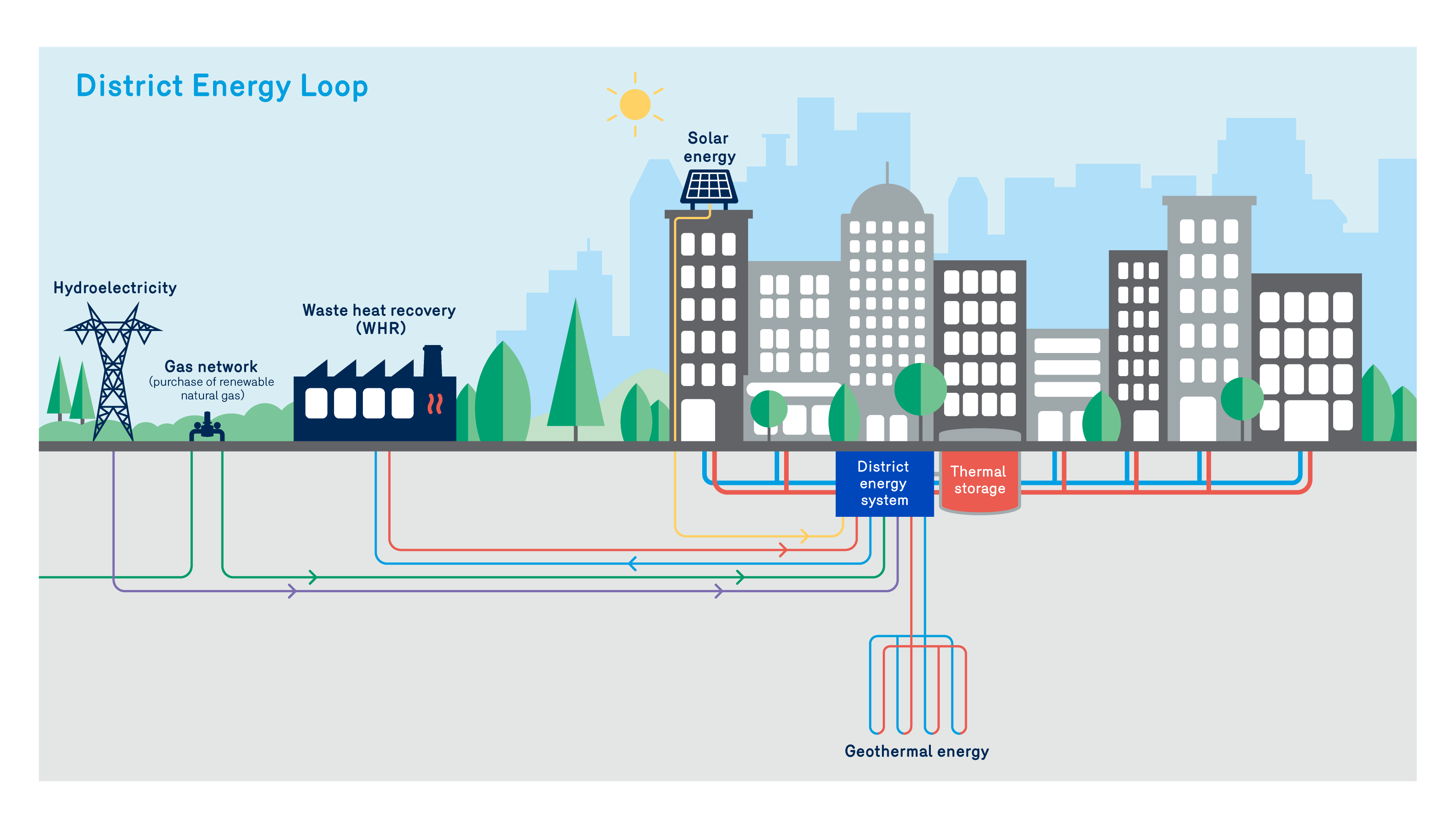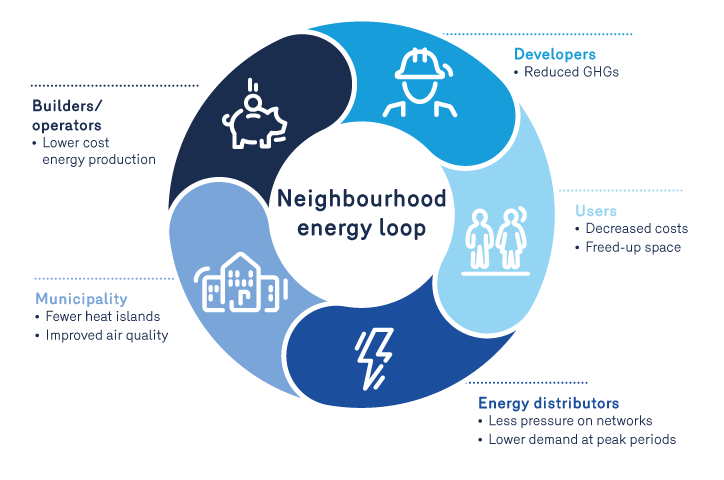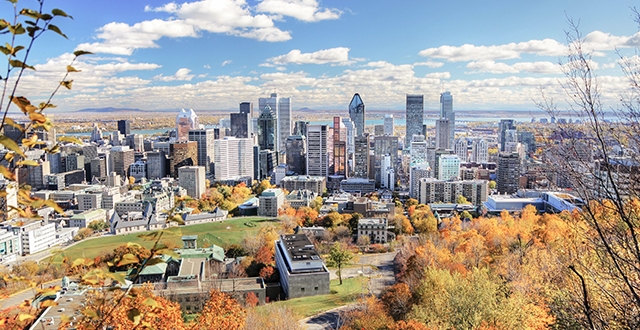What are Energy Loops?
Within a single neighborhood, an energy loop acts as an energy distribution network, providing turnkey heating and cooling services.
They allow customers to decarbonize as the energy sources that power them are renewable.
These networks can be powered by geothermal, waste heat recovery (WHR), solar, or any other available renewable energy sources. Peak demand can be met by renewable natural gas combined with thermal storage strategies. There are two main types of loops: district energy loops and waste heat recovery loops.
The District Energy Loop
The purpose of the district energy loop is to centralize the energy infrastructure of a new district and optimize energy performance by taking advantage of mixed use, economies of scale, and energy efficiency.

Success Criteria
The success criteria for a district energy loop are primarily based on neighborhood density, mixed use, openness to innovation, and competitive energy pricing.
In addition, an integrated approach with all stakeholders upstream is definitely the way forward. Real estate developers need to adapt their construction practices to promote the integration of renewable energy sources and improve the environmental performance of projects.
A virtuous cycle
In an energy loop project, the practice of energy pooling yields economic and environmental benefits for all participating group members. This interconnected system creates a ‘virtuous circle,’ where each benefit reinforces and amplifies the others. The diagram below illustrates this idea.

Numerous benefits
Better air quality
Energy loops can help achieve GHG reduction targets and significantly improve air quality for the benefit of all citizens. A district energy loop effectively reduces GHG emissions associated with the combustion of boilers for space and water heating.
Fewer heat islands
Mitigating heat islands is crucial in highly urbanized areas, where excess heat can negatively impact residents’ quality of life and health. By reducing heat dissipation into the atmosphere, we can create a more sustainable environment.
Drinking water savings
The centralization and efficiency of HVAC systems reduce the water consumption required to operate heat production and evacuation equipment in buildings.
Energy transition and green economy
Energy loops are innovative infrastructure projects that make a concrete contribution to the energy transition and to achieving the environmental targets set by governments and the City of Montréal.
Lower energy bills
Improved energy efficiency directly leads to lower energy bills for building owners and users. Additionally, the scalability of an energy loop enables the gradual integration of various local renewable energy sources. These sources may include plant biomass from sawmills or furniture factories, geothermal energy, solar energy, and residual heat from industrial processes or data centers. Over time, building owners can reap the benefits of clean, cost-effective energy, either partially or entirely.
Lower costs, more space
Neighborhood energy networks offer a dual advantage. Firstly, they enhance operational reliability by eliminating the need to find skilled workers to manage the complexity of new equipment and the increased responsibility associated with maintaining components in a centralized HVAC system (such as water towers and refrigerants). Secondly, centralizing equipment reduces operating costs and frees up space, which can be leveraged for optimizing space utilization or generating rental income. Additionally, obtaining a recognized energy or environmental certification positively impacts the rental or sale value of the premises.
Improved energy resilience
Energy loops play a crucial role in reducing energy consumption, which, in turn, alleviates pressure on distribution networks—particularly during peak periods. By mitigating demand, energy loops can minimize the risk of overloads and breakdowns. Additionally, they contribute to cost savings by reducing the need for expensive energy imports and the expenses associated with upgrading distribution networks. Furthermore, power plants within these loops ensure reliable energy production and enhance redundancy, providing resilience in case of grid failures.
Access to external capital
By outsourcing energy production and distribution infrastructure, the energy loop can be integrated into the project at no extra cost to the property developer and the customers served. In addition, several financial assistance programs are available in Québec to improve the profitability of energy loop projects.
High environmental performance
The objectives of carbon neutrality and green energy certifications are much more cost-effective and easier to achieve within a multi-building approach.
Waste Heat Recovery Loops

What is Waste Heat Recovery?
WHR involves capturing the heat discarded by a neighboring exothermic facility and utilizing it for substantial and predictable heating or air conditioning demand.
In Quebec, approximately 40% of the energy consumed by large industries currently goes to waste: the potential for WHR is huge.
It's a win-win situation!
By recovering the thermal energy that would otherwise be released into the environment, WHR enables clients to decarbonize. The principles of the circular economy are applied: one person’s waste is another one's input.
The exothermic company that donates its heat can receive additional remuneration, and the company that consumes the heat usually benefits from an advantageous tariff compared to market costs.
WHR projects are therefore a cost-effective solution for decarbonizing heating systems, and the resulting potential GHG savings are significant.

November 14, 2025
Call for Tenders 25-917
Design and Construction of a Thermal Plant
Énergir Développement Inc. (EDI), hereinafter referred to as “Énergir,” is actively involved in several energy loop projects currently under development in Québec. In these projects, Énergir will provide a comprehensive energy service by ensuring the design, construction, operation, and maintenance of the loop to deliver long-term energy supply to clients.
This project aims to build a thermal plant to meet the heating and cooling needs of a new real estate development located in Montréal. The new Thermal Plant will supply chilled water and heating water to the entire future district, which will be a mixed-use development of approximately 5,000,000 square feet and 5,000 residential units.
The project will be carried out by a contractor under a contractual model inspired by the Integrated Project Delivery (“IPD”) approach, as described in the tender documents. At the end of the selection process, a framework agreement will be established to enable the execution of projects under the IPD model.
All bidders wishing to participate and receive the documentation for this call for tenders must send an email request to Mr. Dominic Faessler at the following address: [email protected].
A partner of choice
Énergir's expertise in energy distribution and energy infrastructure management makes us a partner of choice. We contribute to the entire value chain of loop projects, from development and financing to pricing, implementation and maintenance.
In addition, a wide range of grants and subsidies are available to support municipalities wishing to develop district energy loops.

